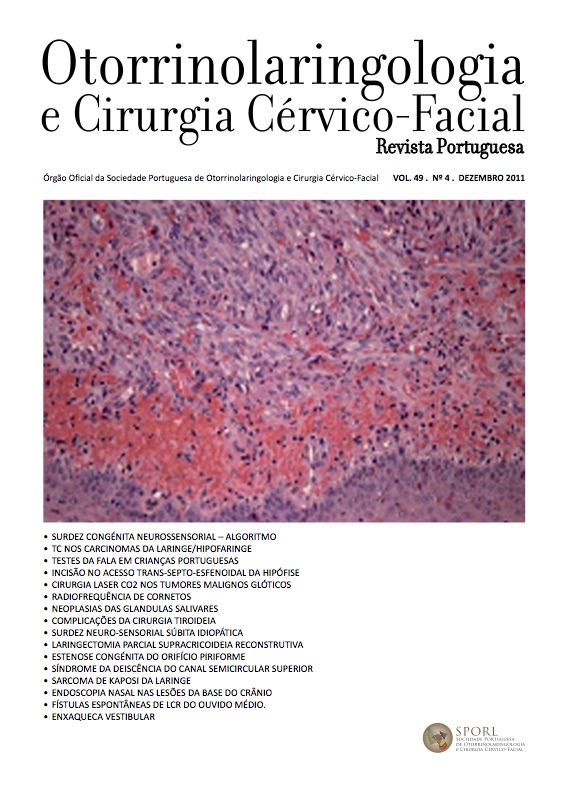Supracricoid partial reconstructive laryngectomy with C.H.E.P. – Department experience for the last 10 years
DOI:
https://doi.org/10.34631/sporl.198Keywords:
supracricoid partial laryngectomy (SCLP), cricohyoidoepiglottopexy (CHEP), speech preservation, pre and postoperative parametersAbstract
For selected glottic and supraglottic cancers it is possible to perform conservation laryngeal surgery with supracricoid partial laryngectomy (SCLP). Depending on the extension of surgical resection achieved reconstruction can be done by cricohyoidopexy (CHP) or Cricohyoidoepiglottopexy (CHEP). The possibility of speech preservation without a permanent stoma is an advantage in successful reconstructions, however the problems with swallowing and aspiration are expected and frequent complications.
Objective: To evaluate the results of laryngeal cancers on patients treated with SCLP-CHEP.
Methods: Retrospective study of patients treated with SCLPCHEP in the last 10 years (2000-2009) at IPO-Lx, with a revision of pre and postoperative parameters.
Results: During this period 33 SCLP-CHEP were reported, although only 31 were included in this study. All patients were male, with a median age of 57,7 years, 45,1% presented a T1b state, average hospital stay of 12,6 days, and in more than 70% of the patients decannulation occurred up to the 19º day (median time being 29,7 days). The nasogastric tube was removed after a median of 48,9 days. The most common long-term complications were aspiration and edema of the arytenoid mucosa. The global survival rate was 100% at 12 months of post operative follow up.
Conclusion: For selected laryngeal cancers, SCLP-CHEP demonstrates to be an excellent option for treatment, allowing function preservation.
Downloads
References
Lay S, Weinstein G. Conservation Laryngeal Surgey, Supracricoid Laryngectomy. Dec 2009 [e-medicine] http://emedicine.medscape.
com/article/851248
Nemr N, Carvalho MB, Köhle J, Leite G, et al.. Functional Study of the voice and swallowing following supracricoid laryngectomy. Rev. Bras.
Otorrinolaringol. [online].2007; 73-n.2: 151-155
Olias J, Mendonça F, Magalhães M, Montalvão P, et al.. Cirurgia parcial horizontal da laringe: laringectomia subtotal reconstrutiva.
Cirurgia da Laringe, Atlas de Técnicas Cirúrgicas, Guia de Dissecção. Círculo Médico - 1ª Edição, 2004: 105-115






